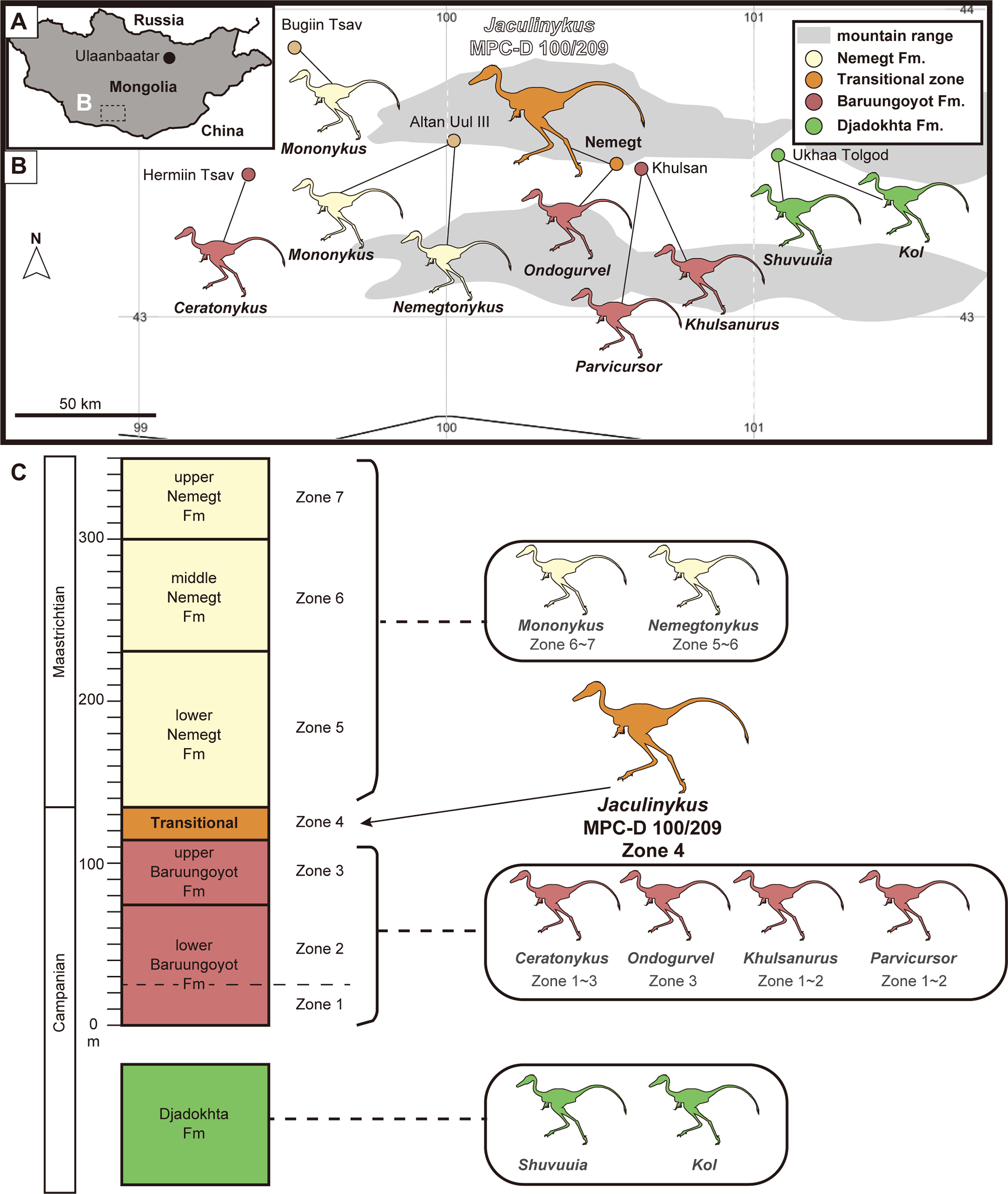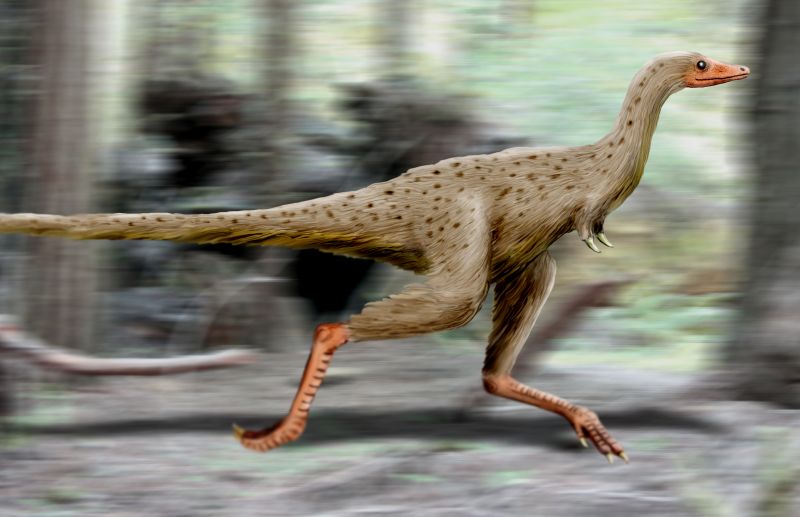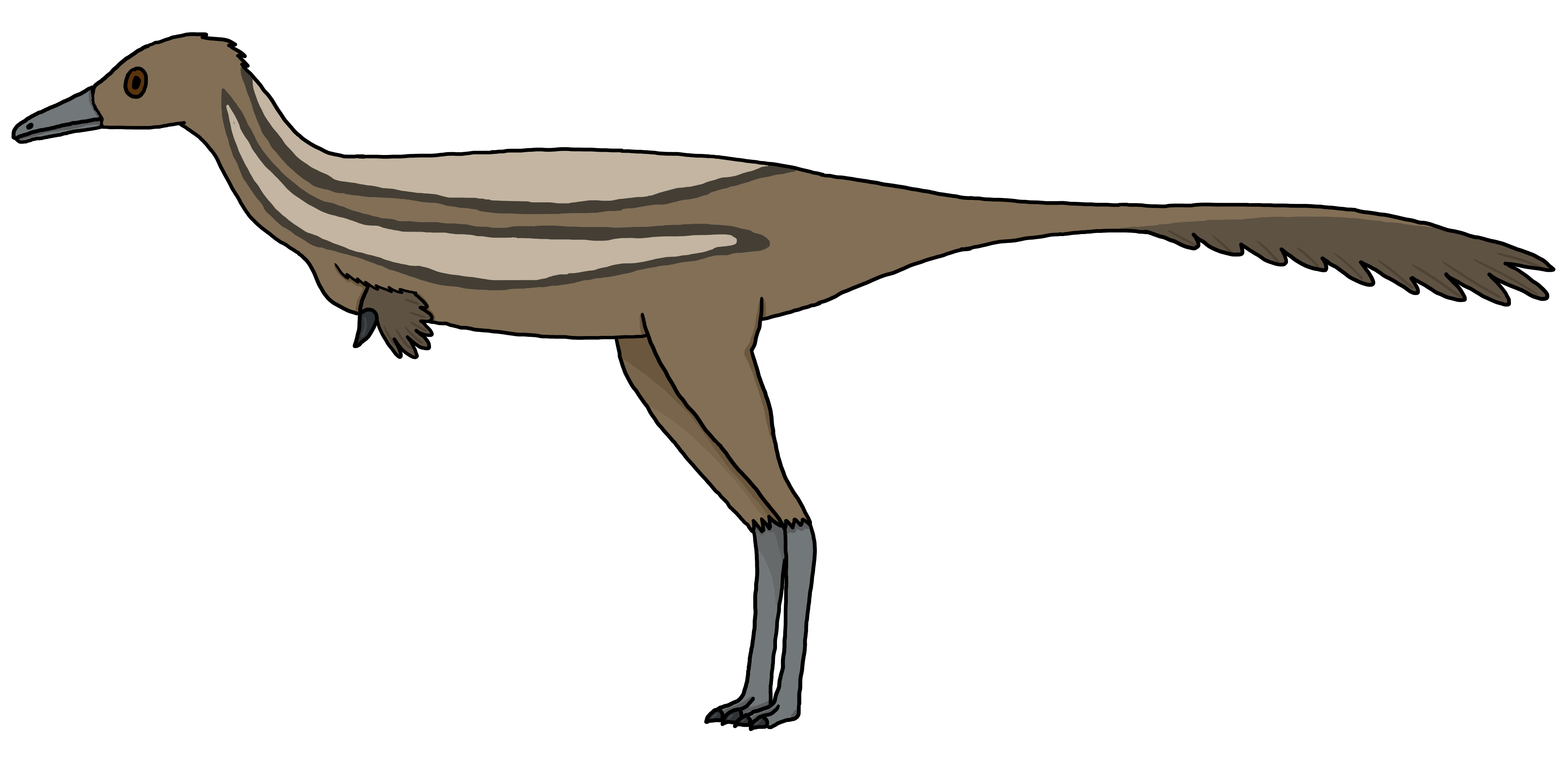|
Alvarezsaurid
Alvarezsauridae is a family of small, long-legged dinosaurs. Although originally thought to represent the earliest known flightless birds, they are now thought to be an early diverging branch of maniraptoran theropods. Alvarezsaurids were highly specialized. They had tiny but stout forelimbs, with compact, bird-like hands. Their skeletons suggest that they had massive breast and arm muscles, possibly adapted for digging or tearing. They had long, tube-shaped snouts filled with tiny teeth. They have been interpreted as myrmecophagous, adapted to prey on colonial insects such as termites, with the short arms acting as effective digging instruments to break into nests. '' Alvarezsaurus'', the type genus of the family, was named for the historian Gregorio Álvarez. History of study Bonaparte (1991) described the first alvarezsaurid, '' Alvarezsaurus calvoi'', from an incomplete skeleton found in Patagonia, Argentina. Bonaparte also named a family, Alvarezsauridae, to contain it. H ... [...More Info...] [...Related Items...] OR: [Wikipedia] [Google] [Baidu] |
Bonapartenykus
''Bonapartenykus'' (meaning "José Bonaparte, José F. Bonaparte's claw") is a monospecific genus of alvarezsauroidea, alvarezsauroid dinosaur from Argentina that lived during the Late Cretaceous (Campanian-Maastrichtian) in what is now the upper Allen Formation of the Río Negro Province. The type and only species, ''Bonapartenykus ultimus'', is known from a nearly articulated but partial skeleton that was found in close association to two incomplete egg, eggs and several clusters of eggshells belonging to the egg fossils, oogenus ''Arriagadoolithus''. ''Bonapartenykus'' was named in 2012 in paleontology, 2012. It has an estimated length of and weight of , making it the largest member of the clade Alvarezsauroidea. Discovery and naming A partial skeleton of a theropod with eggs was collected in a surface of approximately 30 m2 in fluvial processes, fluvial sandstone, sandstones of the upper Allen Formation in northwestern Patagonia, Argentina. The locality has also produced s ... [...More Info...] [...Related Items...] OR: [Wikipedia] [Google] [Baidu] |
Trierarchuncus
''Trierarchuncus'' (meaning "captain hook," after its single-clawed hands) is a monotypic genus of alvarezsauridae, alvarezsaurid theropod which includes a single species, ''Trierarchuncus prairiensis'', mainly known from fossils found in deposits of the Hell Creek Formation in Montana. It is the youngest known alvarezsaurid and one of the last non-avian dinosaurs, going extinct during the Cretaceous–Paleogene extinction event, which occurred approximately 66 million years ago. Discovery and naming The first remains were discovered in Montana in 1980 and it was informally named as the "Hell Creek alvarezsaur" by Hutchinson and Luis M. Chiappe, Chiappe (1998).Hutchinson and Luis M. Chiappe, Chiappe, (1998). The first known alvarezsaurid (Theropoda: Aves) from North America. ''Journal of Vertebrate Paleontology''. 18(3), 447–450. The then unnamed species was not mentioned again until it was mentioned briefly in the 2018 Society of Vertebrate Paleontology abstract book. The specie ... [...More Info...] [...Related Items...] OR: [Wikipedia] [Google] [Baidu] |
Ceratonykus
''Ceratonykus'' (meaning "horned claw") is a monospecific genus of alvarezsaurid dinosaur from Mongolia that lived during the Late Cretaceous (late Campanian stage, 72.1 Ma) in what is now the Barun Goyot Formation. The type and only species, ''Ceratonykus oculatus'', is known from a fragmentary skeleton, including an incomplete skull, of an adult individual. It was named and described in 2009 by Vladimir Alifanov and Rinchen Barsbold. Its describers questioned the traditional placement of alvarezsaurs in Theropoda, instead suggesting they were ornithischians, but this has not been accepted since. ''Ceratonykus'' has an estimated length of and weight of . It has been considered as a possible junior synonym of '' Parvicursor''. Discovery and naming In 2003, a partial skeleton of an alvarezsaurid was discovered in the Barun Goyot Formation of the Khermiin Tsav locality, Mongolia by the Paleontological Center of the Mongolian Academy of Sciences (MPC) preparator Otkhoon Zhargal. ... [...More Info...] [...Related Items...] OR: [Wikipedia] [Google] [Baidu] |
Dzharaonyx
''Dzharaonyx'' (meaning "Dzharakuduk claw", named after the type locality) is a genus of alvarezsaurid theropod from the Late Cretaceous Bissekty Formation of Uzbekistan. The type species, type and only species is ''D. eski''. The specific epithet ''"eski"'' is an Uzbek language, Uzbek word for "old". Discovery and naming All remains of ''Dzharaonyx'' were discovered at a single locality called Dzharakuduk, which is in the Kyzylkum Desert of Uzbekistan. The first remains belonging to alvarezsaurid dinosaurs, which would later be referred to ''Dzharaonyx'' were discovered by Lev Nesov during the period between 1977-1994 who was a paleontologist employed by the Soviet Union. Additional remains would be found in the period between 1997-2006 by the so-called "URBAC joint-paleontological expedition", so named because it involved the collaboration of five countries — Uzbekistan, Russia, UK, Britain, United States, America, and Canada. During both of these periods of expedition, re ... [...More Info...] [...Related Items...] OR: [Wikipedia] [Google] [Baidu] |
Albertonykus
''Albertonykus'' (meaning "Alberta claw") is an alvarezsaurid dinosaur from the Maastrichtian-age (Upper Cretaceous) rocks of the Horseshoe Canyon Formation of Alberta, Canada. It is known from forelimb and hindlimb remains from multiple individuals. All but two of the specimens come from a bonebed dominated by ''Albertosaurus'', located at the top of Unit 4 of the Horseshoe Canyon Formation,Larson, D. W., Brinkman, D. B., & Bell, P. R. (2010). Faunal assemblages from the upper Horseshoe Canyon Formation, an early Maastrichtian cool-climate assemblage from Alberta, with special reference to the Albertosaurus sarcophagus bonebed This article is one of a series of papers published in this Special Issue on the theme Albertosaurus. Canadian Journal of Earth Sciences, 47(9), 1159-1181. dating to ~68.5 million years ago. ''Albertonykus'' is interpreted as having fed on wood-nesting termites because the forelimbs appear specialized for digging, but are too short for burrowing. ''Albert ... [...More Info...] [...Related Items...] OR: [Wikipedia] [Google] [Baidu] |
Jaculinykus
''Jaculinykus'' (meaning "Jaculus claw") is an extinct genus of alvarezsaurid theropod dinosaur from the Late Cretaceous Baruungoyot Formation of Mongolia. The genus contains a Monotypic taxon, single species, ''J. yaruui'', known from a nearly complete articulated skeleton including bones of the skull. ''Jaculinykus'' is notable for its unique hand, which has a hypertrophied first digit and greatly reduced second digit, which is intermediate between the tridactyl hand of ''Shuvuuia'' and monodactyl hand of ''Linhenykus''. Discovery and naming The ''Jaculinykus'' holotype specimen, Mongolian Academy of Sciences, MPC-D 100/209, was discovered in sediments of the Baruungoyot Formation (Nemegt locality), of Ömnögovi Province, Mongolia. The specimen consists of a nearly complete skeleton with most of the skull. In 2023, Kubo ''et al''. Species description, described ''Jaculinykus yaruui'' as a new genus and species of parvicursorine alvarezsaurid based on these fossil remains. Th ... [...More Info...] [...Related Items...] OR: [Wikipedia] [Google] [Baidu] |
Qiupanykus
''Qiupanykus'' (IPA: , meaning "claw from the Qiupa Formation") is an extinct genus of alvarezsaurid theropod from the Late Cretaceous Qiupa Formation of Henan Province, China. The type and only species is ''Q. zhangi'', named for Shuancheng Zhang, who assisted in finding the fossils of ''Qiupanykus''. Discovery The Qiupa Formation is located in the Tantou Basin which is in Luanchuan County of the Henan province in China. Lithological correlation of the local strata has dated the Qiupa Formation to the Late Cretaceous. More specific analyses have suggested that the formation dates to the end of the Maastrichtian stage, which was the final stage of the Mesozoic Era. This would make ''Qiupanykus'' and its contemporaries were among the last-surviving non-avian dinosaurs. The Qiupa Formation preserves a wide variety of dinosaur eggs, many of which have been named as ootaxa, as well as body fossils. Alvarezsaurid remains were found near the village of Guanping in Luanchuan Cou ... [...More Info...] [...Related Items...] OR: [Wikipedia] [Google] [Baidu] |
Parvicursor
''Parvicursor'' (meaning "small runner") is a genus of tiny maniraptoran dinosaur with long slender legs for fast running. Discovery and naming The holotype PIN no. 4487/25, mostly consisting of vertebrae, the pelvis and the right hindlimb, was discovered in 1992 and described in 1996.Karhu, A.A. and Rautian, A.S. (1996). "A new family of Maniraptora (Dinosauria: Saurischia) from the Late Cretaceous of Mongolia". ''Paleontological Journal'' ''Russian Academy of Sciences'' 30(5): 583-592. It was discovered in Barun Goyot Formation of Khulsan, Mongolia, dated at approximately 72 million years old. Description At only about from snout to end of tail, and in weight, it was initially seen as one of the smallest non-avian dinosaurs known from an adult specimen.Which was the smallest dinosaur? Royal Tyrrell Mu ... [...More Info...] [...Related Items...] OR: [Wikipedia] [Google] [Baidu] |
Ondogurvel
''Ondogurvel'' (meaning "egg lizard") is a genus of alvarezsaurid dinosaur from the Late Cretaceous (Campanian) Barun Goyot Formation in southern Mongolia. The type and only species is ''O. alifanovi'', known from a partial skeleton consisting of fragments of two last dorsal vertebrae, three anterior sacral vertebrae, right ilium, left and right pubis and ischium, articulated right tibia, fibula, metatarsals II and IV, and phalanges IV-1 and IV-2, right carpometacarpus, left and right manual phalanx II-1, right femur, left pedal phalanx II-1, and fragments of unidentified phalanges. Discovery and naming In 2022, the type species ''Ondogurvel alifanovi'' was named and described by Alexander O. Averianov and Alexey V. Lopatin. The generic name, "''Ondogurvel''" combines the Mongolian words "egg" and "lizard". The specific name, "''alifanovi''" honors the late Russian paleontologist Vladimir Alifanov who found the holotype specimen (PIN 5838/1) in 1999. Description ''Ondogurve ... [...More Info...] [...Related Items...] OR: [Wikipedia] [Google] [Baidu] |
Patagonykus
''Patagonykus'' (meaning "Patagonian claw") is a genus of theropod dinosaur from the Upper Cretaceous of Argentina. This alvarezsauroid was discovered in exposures of the Portezuelo Formation (Turonian-Coniacian) of the Rio Neuquén Subgroup in the Neuquén Basin, Neuquen Province of Patagonia, Argentina. The holotype consists of an incomplete but well-preserved skeleton, lacking a skull, but including many vertebrae, the coracoids, a partial forelimb, pelvic girdle, and hindlimbs. ''Patagonykus'' has been classed with the Alvarezsauridae, a family which includes such taxa as the Mongolian '' Mononykus'' and the Argentinian '' Alvarezsaurus''. In 2010 Gregory S. Paul estimated its length at 1 meter (3.3 ft) and its weight at 3.5 kg (7.7 lbs). Classification Agnolin ''et al.'' (2012) originally placed ''Patagonykus'' within Alvarezsauridae, within the clade Patagonykinae as sister taxon to ''Bonapartenykus''. Makovicky, Apesteguía and Gianechini (2012) found it to be in a polyto ... [...More Info...] [...Related Items...] OR: [Wikipedia] [Google] [Baidu] |
Linhenykus
''Linhenykus'' is an extinct genus of alvarezsaurid theropod dinosaur from the Late Cretaceous of Inner Mongolia, China. It is the most basal known member of the Parvicursorinae. The genus gets its name from Linhe, a city near the site where the fossil was first found and Greek ''nykus'', "claw". The specific name is derived from Greek ''monos'', "single", and ''daktylos'', "finger", a reference to the fact that it is the only known non-avian dinosaur to have had but a single digit. Description ''Linhenykus'' was a small dinosaur, measuring long and weighing . Its femur length is . Alvarezsauroids are known for their short forelimbs, each with a single greatly enlarged second digit. Although alvarezsaurids were once thought to have only a single digit on each forelimb, more recent evidence has shown that most species have reduced third and fourth digits. ''Linhenykus'' is the first known alvarezsaurid to have only a single, second digit. Although a reduced third metacarpal ... [...More Info...] [...Related Items...] OR: [Wikipedia] [Google] [Baidu] |
Heptasteornis
''Heptasteornis'' is the name given to a dubious genus of alvarezsaurid dinosaur from the Late Cretaceous. The type (and only known) species is ''Heptasteornis andrewsi'', described as a presumed gigantic prehistoric owl in 1975. It was previously included in '' Elopteryx nopcsai'' and indeed the holotypes of both were believed to be from the same individual as they were discovered, and initially were assigned the same specimen number. This appears to be in error however (see below).Harrison & Walker (1975) The material was discovered in Romania by Franz Nopcsa, in the late Maastrichtian Sânpetru Formation ( Rognacian faunal stage, deposited c. 68 - 66 million years ago) of the Haţeg Basin in Transylvania. The scientific name means "C.W. Andrews' Transylvanian bird", after the namer of ''Elopteryx'', and Ancient Greek ''hepta'' (ἑπτά) "seven" + ''asty'' (άστυ) "city" + ''ornis'' (όρνις) "bird"; the Latin ''septum urbium'' or the German ''Siebenbürgen'' - mean ... [...More Info...] [...Related Items...] OR: [Wikipedia] [Google] [Baidu] |









